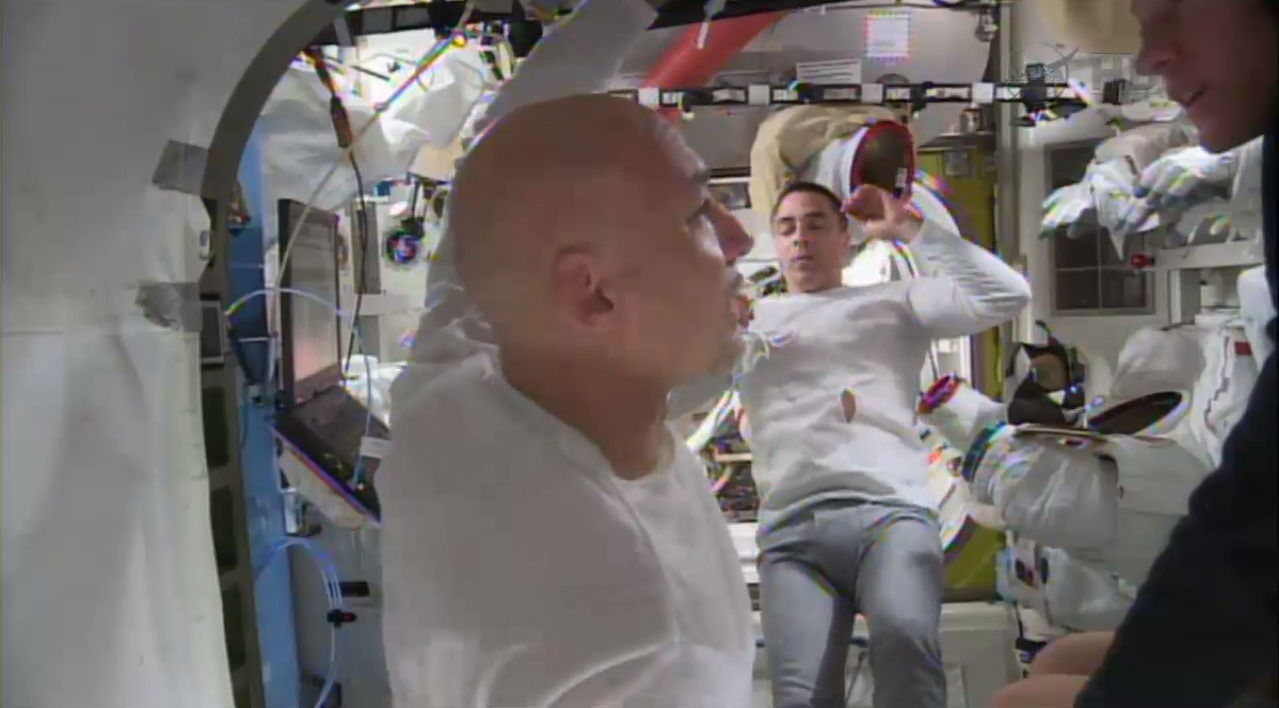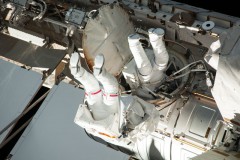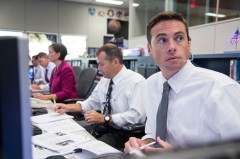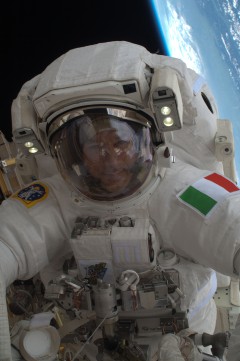
Expedition 36 spacewalkers Chris Cassidy and Luca Parmitano were dramatically summoned back to the International Space Station’s Quest airlock earlier today, a little more than 92 minutes into their planned 6.5-hour Extravehicular Activity (EVA). The two men successfully completed a number of key tasks on EVA-23, but an excessive build-up of water in Parmitano’s helmet developed, impairing both his hearing and vision, and prompted Flight Director David Korth to terminate the spacewalk. An expedited protocol then kicked into action to get Cassidy and Parmitano back to the airlock as quickly as possible, and 32 minutes elapsed between Korth’s decision and the physical removal of Parmitano’s helmet in the safety of Quest’s inner equipment lock.
EVA-23—the 23rd station-based spacewalk from the U.S. Segment—followed hard on the heels of last Tuesday’s highly successful EVA-22, during which Parmitano became Italy’s first spacewalker. Plans for today’s excursion included Parmitano routing the 1553 data cables and Ethernet cables in readiness for the arrival of Russia’s Nauka science module, which is scheduled for later this year or early in 2014, together with the reconfiguration of Y-Bypass jumper cables by Cassidy on the boxy Z-1 truss. Several other activities were also planned, although most of these have been unavoidably deferred by the problems with Parmitano’s space suit. Plans for an “additional” EVA to complete the remainder of today’s scheduled tasks are already underway, although it was not clear at the time of writing when this would occur and its impact on other critical station activities.

Today’s spacewalk began nominally, with U.S. astronaut Karen Nyberg and Russian cosmonaut Fyodor Yurchikhin helping Cassidy and Parmitano into their snow-white suits and running the checklists inside Quest. After post-sleep and personal hygiene, the spacewalkers jumped right onto a well-trodden path of 60 minutes “pre-breathing” on masks, during which time the airlock’s inner “equipment lock” was be depressed from its “ambient” 14.7 psi down to 10.2 psi. Their next step was to actually don and purge their suits—with Parmitano’s ensemble emblazoned with the red, white, and green stripes of the Italian national flag—after which the atmosphere was repressurized to 14.7 psi. The astronauts then entered a nominal pre-breathing period, lasting about 50 minutes, followed by a further 50 minutes of In-Suit Light Exercise (ISLE). This protocol was first debuted on the STS-134 shuttle mission in May 2011 and involved Cassidy and Parmitano flexing their knees for four minutes, resting for one minute, and repeating over and over until the 50 minutes are up. ISLE serves to remove nitrogen from the spacewalkers’ blood in a much shorter time period.
Like EVA-22, today’s spacewalk preparations ran crisply and ahead of schedule. Original plans called for EVA-23 to begin at 8:10 a.m. EDT, and a little under an hour ahead of this start time, Nyberg and Yurchikhin had already transferred their comrades and equipment over to Quest’s outer “crew lock” and closed the hatch between the two locks. Depressurization of the crew lock was in work by 7:30 a.m., with a brief pause at 5 psi for standard leak checks, after which the pressure continued to drop down to near-vacuum. At 2 psi, the remaining oxygen in the crew lock was vented into space, and at 7:57 a.m. Cassidy and Parmitano switched their suits’ life-support utilities onto internal battery power. This signaled the official start of EVA-23, a full 13 minutes ahead of schedule.

As planned, Parmitano departed the airlock first and began configuring tether and equipment, before Cassidy joined him and the two men checked themselves before splitting up on their separate first tasks. Cassidy (designated “EV1” and wearing red stripes on the legs of his suit for identification) returned to a rather thorny site on the port side of the box-shaped Z-1 truss, atop the station’s Unity node. He quickly plunged into the task of concluding the reconfiguration of Y-Bypass jumper cables which started on EVA-22. Due to the sheer volume of cables, connectors, and jumpers—caused by numerous electrical and data system upgrades over the years—the area has been nicknamed “The Rat’s Nest.” By 8:35 a.m., he had completed the task and would have moved next to the P-1 and S-1 trusses to begin the installation of four radiator V-guides onto the two Radiator Grapple Bars (RGBs).
By this time, however, the first signs of trouble were already brewing.
After he and Cassidy parted ways at the airlock, Parmitano translated “beneath” the Unity node toward its aft end cone, where he temporarily stowed a bag of data cables. He mated the 1553 data cables, hooking up the Power and Data Grapple Fixture (PDGF) on Russia’s Zarya module to ISS data systems on the Avionics Panel of the Tranquility node. This will ultimately permit the Canadarm2 robotic manipulator arm to access the Russian Segment of the space station. He then embarked on what should have been an hour-long task of retrieving and installing the Ethernet cable for Russia’s long-awaited Nauka module, connecting one end to a space Ethernet connector at the junction between the Destiny, Unity, and Tranquility modules; he then began the process of laying out the cable as he worked his way aft toward the Russian Segment.

By this point, EVA-23 was about 45 minutes ahead of the timeline. Then, at about 8:42 a.m., Parmitano made his reference to water inside his “Snoopy” communications cap. He was quickly joined by Cassidy, who verified that up to 800 milliliters of water was visible inside Parmitano’s helmet. Initially suspecting a coolant leak, he reduced the flow rate, and the possibility of a drinking bag leak seemed unlikely as it was already dry. Monitoring the situation from the Mission Control Center in Houston, Texas, was a team headed by ISS Flight Director Korth and featuring astronaut Shane Kimbrough as Capcom. At 9:06 a.m., with Parmitano now reporting water in his eyes, Korth gave the call to terminate EVA-23. Under his directive, Parmitano would proceed immediately toward the airlock, whilst Cassidy stowed the Ethernet cable and cleaned up the work site.
Within five minutes, Parmitano was back at Quest, by now with water droplets entering his eyes, nose, and mouth. Cassidy handled the closure of the hatch, which was locked at 9:26 a.m. and repressed back up to ambient ISS pressures about 11 minutes later. “He looks miserable,” Cassidy said of his crewmate, “but he’s okay.” At 9:38 a.m., the hatch connecting the outer crew lock with the inner equipment lock was open and Nyberg removed Parmitano’s helmet, releasing a flurry of water droplets in the process.
The official “end time” for EVA-23 was 9:29 a.m. EST, concluding a 92-minute spacewalk. This duration established today’s partially-successful excursion as one of the shortest station-based EVAs in history. Although several “intravehicular” walks have taken place, the shortest ISS EVA took place on 24 June 2004 by Russian cosmonaut Gennadi Padalka and U.S. astronaut Mike Fincke. They were supposed to replace a faulty circuit breaker, but their spacewalk was cut short—after just 14 minutes—when the primary oxygen bottle in Fincke’s space suit began rapidly losing pressure.

It cannot be doubted that the situation will unfurl in the coming days, as NASA identifies the cause of the water build-up in Parmitano’s helmet and what corrective actions can be put in place. At one stage, the astronaut was obliged to gulp down the globules of water, which he described as exhibiting an unusual and unpleasant taste and therefore possibly indicative of a cooling system glitch in his suit.
With the unfortunate conclusion to EVA-23, it is fortuitous that neither Parmitano or Cassidy suffered any harm in the harsh vacuum and hostile environment. Several tasks for the planned 6.5-hour spacewalk were completed—the Y-Bypass jumper configuration, the 1553 data cable connections, and a couple of others—with several begun, but left incomplete. Had the EVA proceeded as intended, Cassidy would have installed four radiator V-guides onto the Radiator Grapple Bars, delivered aboard SpaceX’s CRS-2 Dragon cargo ship in March 2013, whilst Parmitano would have joined him to remove and relocate the 7-foot-tall Wireless Video System External Transceiver Assembly (WETA) from its current position on the P-1 truss to the aft end cone of the Harmony node. The spacewalkers would also have attended to several other tasks, including the replacement of a camera on the Exposed Facility of Japan’s Kibo laboratory and the removal of a multi-layer insulation blanket from the failed Main Bus Switching Unit (MBSU)-1. These objectives may be added to another EVA in the near future, although it remains to be seen when such an excursion will take place.
Want to keep up-to-date with all things space? Be sure to “Like” AmericaSpace on Facebook and follow us on Twitter:@AmericaSpace




4 Comments
4 Pings & Trackbacks
Pingback:NASA Team Formed to Investigate EVA-23 Incident | Space Safety Magazine
Pingback:Hot EVA Nights: The Spacewalking Summer of 2013 « AmericaSpace
Pingback:Andreas Mogensen, Denmark’s First Astronaut, Assigned to 2015 Soyuz Mission « AmericaSpace
Pingback:Expedition 36 Crew Home Safe After 166-Day Space Station Mission « AmericaSpace